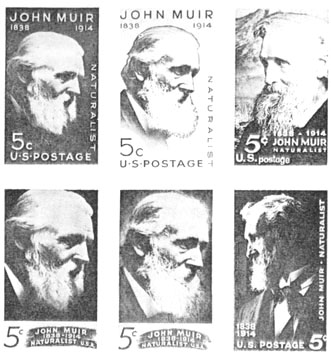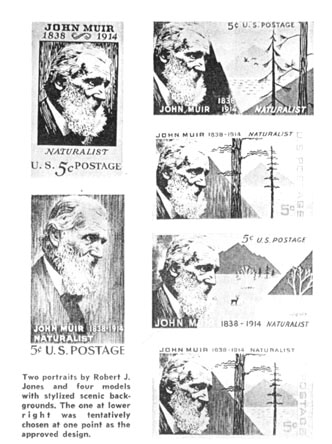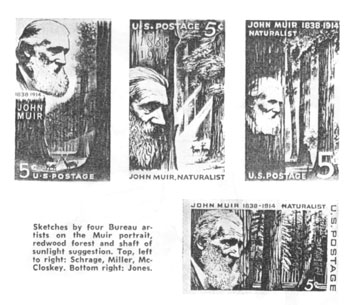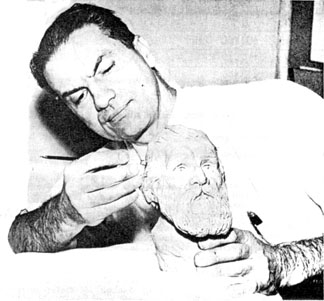the john muir exhibit - stamps - faries 1964
John Muir - 1964 Postage Stamp
by Belmont Faries

Although there are requests in Post Office Department files dating back to 1938, the successful campaign for a stamp honoring John Muir actually began in April of 1961 when residents of Martinez, Calif., where the noted naturalist and conservationist had made his home, enlisted the aid of Senator Clair Engle.
Muir was born in Dunbar, Scotland, April 21, 1938. When he was 11 his family came to the United States and settled in the Wisconsin wilderness near the present site of the city of Portage.
Young Muir attended the University of Wisconsin but left it, he said, for "the university of the Wilderness." He walked to the Gulf of Mexico and later moved on to California and Alaska studying mountains, glaciers and trees. Through his writings he helped save California's giant redwoods by the creation of Yosemite National Park.
In 1880 Muir married Louie Wanda Strentzel of Martinez and made his home there, though his travels continued. He died while on a visit to Los Angeles on December 24, 1914. The John Muir Memorial Association, which asked for the stamp, is working to develop the Muir home in Martinez as a National Historic Site.
On May 8, 1963, the Stamp Advisory Committee recommended to Postmaster General J. Edward Day that a John Muir commemorative be issued as part of the 1963 program.
Senator Engle made the first public announcement of the proposed Muir stamp on June 29, 1963, noting that the 5-center commemorative would be issued in the fall. He added, "Americans owe a great debt to John Muir for his role in preserving one of the most awe-inspiring of Nature's wonders - the giant Sequoia trees. I hope that issuance of the Muir postage stamp will focus attention on the ned for increased efforts to preserve our national resources."
The official Post Office Department announcement for publication on June 30 listed a one-color 5c stamp honoring John Muir, American naturalist, along with four other commemoratives, for City Mail Delivery, Sam Houston, Cordell Hull, and a John James Audubon bird painting in the fine arts series.
Developing the Design

The Post Office Department asked the Bureau of Engraving and Printing to prepare a model for a John Muir stamp on May 15, 1963 and the four Bureau artists, Victor S. McCloskey, Jr., Robert L. Miller, Robert J. Jones and William K. Schrage, prepared sketches. one of these a horizontal design by jones with a portrait of Muir at the left against a rather stylized mountain background, sent to the Post Office Department on July 22, was tentatively approved.
About this time it became obvious that it would be necessary to issue a Red Cross stamp. Although requests for a REd Cross Centenary commemorative had been rejected, high Justice Department officials who had worked with the Red Cross in the Cuban prisoner exchange program had made commitments which postal officials did not feel they could ignore. To stay within the voluntary limit of 15 commemoratives a year which had been set by Postmaster General Day it would be necessary to delay a stamp already in the 1964 program. The John Muir commemorative was the obvious choice.
Announcement that the Red Cross stamp would be issued and the Muir commemorative delayed until February 1964 was made by Acting Postmaster General Sidney W. Bishop on September 8. Mr. Bishop noted that the Muir stamp had been scheduled for single color printing because of the heavy press requirements for the Christmas stamp and other multi-color commemoratives, but that the delay would make it possible to produce a full color Muir stamp.
Both Senator Engle and the art members of the Stamp Advisory Committee had expressed some dissatisfaction with the tentatively selected design. Senator Engle felt the scenic background should be more recognizably Californian and specifically should show the redwoods Muir had fought to save. The Bureau was asked for new sketches which would show a portrait of Muir against the trunk of a giant redwood with shafts of sunlight angling through the forest.
Each of the Bureau's four artists prepared a sketch meeting this description. They were sent to the Post office Department on October 7.
Meanwhile, postal officials had called in Rudolph Wendelin, the Forest Service artist who had designed one of the most attractive of all United States multi-color stamps, the Forest Conservation issue of 1958, adapted Charles M. Russell's "The Trail Boss" into the Range Conservation stamp of 1961, and collaborated with Maurice Eysenburg in the design of the Fifth World Forestry Congress stamp of 1960.

Wendelin submitted a rough pencil sketch which, apparently by coincidence, included the same elements suggested to the Bureau -- a large bearded portrait of Muir in a redwood forest scene with shafts of sunlight through the trees lighting a tiny figure also representing Muir on the forest floor. It also carried Muir's name and the description "Conservationist." All of the Bureau sketches had used "Naturalist."
Postal officials liked WEndelin's conception and asked him to prepare finished art. Although Wendelin's work has been in the conservation field (one of his regular assignments is protecting the public image of Smokey the Bear) he knew little about Muir personally. So his first step was to read upon on his subject to gain an insight into his character. As part of his study he prepared a variety of watercolors and two sculptured busts, one in clay and one carved from solid walnut.
For his portrait he wanted a picture of Muir as an old man gazing upward at his mountains and trees. He found such a photograph used as the frontispiece of Linnie Marsh Wolfe's biography "John of the Mountains," but for his composition reversed the portrait and removed the hat.
The colors were carefully worked out. There was no doubt about a deep brown for the trunks of the trees and a dark green for the foliage. In a preliminary sketch Wendelin tried yellow for the shaft of sunlight, but he was a little reluctant to use a color combination so close to his Forest Conservation stamp and he realized that yellow might create printing problems. Later, after he had an opportunity to visit the Muir Woods and see for himself the bright green of the sunlight foliage and the deep green of the shaded areas he was glad two shades of green had been used for the stamp.
Although his pencil sketch had been approved as the basis for the stamp design Wendelin worked out an alternate proposal with a head and shoulders portrait of Muir to avoid a floating effect and with a mountain and water scene in blue at the left.
But postal official preferred his finished sketch of his first suggestion with minor changes in the hat and beard of the tiny figure and more of an upswept wave in the hair of the larger portrait.
Wendelin's final version was approved by Postmaster General Gronouski on November 12, but the design was not made public until February 8, 1964, when Mr. Gronouski headed a group of Federal and State officials at the dedication of the seven-acre John Muir Park overlooking the University of Wisconsin campus and Lake Mendota at Madison, Wisconsin.

Stamp Production
Working from Wendelin's approved model, Matthew D. Fenton engraved the portrait and vignette and Kenneth C. Wiram the lettering and numeral. The die proof was approved by Postmaster General Gronouski on December 9, 1963 and the Bureau received an order to print on December 12.
In addition to the flat master plate; 27686, five printing plates were made for this stamp, 27687, 27688, 27689, 27692 and 27693.
Printing started December 30, 1963 on one of the Bureau's two-plate Giori presses and was completed on February 10, 1964, with a total production of 633,107 sheets of 200 (127,021,400 stamps).
For plates 27687 and 27688, sent to press together on December 30, there were 164,975 impressions (32,995,000 stamps) and 167,579 impressions (33,519,400 stamps) respectively. For plates 27692 and 27693, the figures were 152,578 impressions (30,515,000 stamps) and 149,957 impressions (29,991,400 stamps).
Plate 27689 was not used and was canceled on March 26, 1964.
The first shipment from the Bureau, 2 million stamps consigned to San Francisco, Calif., was made on April 2. By August 15, 1964 a total of 119,310,000 of the stamps had been delivered to post offices and the Philatelic Sales Agency.
Philatelic Data
Five cent brown, green and yellow-green on white wove paper in pregummed sheets, vertical format, 0.84 by 1.44 inches, printed from 200 - subject plates on one of the Bureau's two-plate Giori presses perforated 11 on the L-perforator and divided into panes of 50 for post offices.
Since plates for this stamp were made before the decision to add the Mr. Zip cartoon character in the selvage, it has no Mr. Zip even though it was issued later than the Sam Houston and Charles M. Russell commemoratives which do have the cartoon character once on each post office pane of 50.
The paper used in the printing came from more than one source and some of the stamps are on sheets manufactured with a fluorescent optical brightener which makes the stamps strongly luminescent under ultraviolet light.
First Day Ceremonies
First day ceremonies for the Muir stamp were held on the steps of the Contra Costa County Court House, Martinez, Calif. on April 29, 1964 under the sponsorship of the Martinez Area Chamber of Commerce, the Contra County Development Association and the John Muir Memorial Association.
Speakers included Hugo Fisher, administrator of the California State Resources Agency, and Assistant Postmaster General William M. McMillan representing the POst Office Department.
The public ceremony was followed by a luncheon at NIck's restaurant with talks on Muir's role as a conservationist by officials of the Forest Service, the National Park Service and the Sierra Club of which Muir was the founder and first president.
Final figures on the Martinez first day showed 446,925 covers canceled and 679,963 stamps worth $33,998.15 sold.
Source: S.P.A. Journal (Society of Philatelic Americans - now defunct) , Vol, 27, No. 1, September, 1964.
About the author: Belmont Faries (1913-1998) was the stamp columnist for The Washington Star for twenty-six years, and was appointed as a member of the U.S. Postal Service's Citizens Stamp Advisory Committee in 1963.
From 1975 to 1990, he served as chairman of the committee, which reviewed and recommended stamp subjects. He continued to serve on the committtee until 1992.
He was editor-in-chief of the quarterly Minkus Stamp and Coin Journal from 1966 to 1986. As a freelance writer and avid stamp collector, he was involved in many other areas of philately, including the founding of the International Philatelic Federation of Journalists.
See Also Letter to the Editor in response to this article by Edward N. Munns.
Home
| Alphabetical Index
| What's New & About this Site